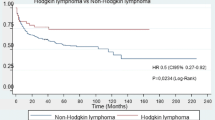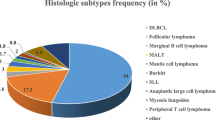Abstract
A clinico-pathological study of malignant lymphoma in Jamaica was undertaken to examine the disease pattern in a predominantly negro population of West African origin. During a 9-year period (1958-66) 260 histologically verified cases of malignant lymphoma were encountered. The distribution of the different histological types was as follows: Hodgkin's disease 50.9%, lymphosarcoma 33%, reticulum cell sarcoma 14.2%, giant follicular lymphoma 1.9%. No cases of Burkitt's tumour were encountered.
This study indicates that malignant lymphoma is not uncommon in Jamaica, and that its distribution pattern is similar to that observed in Europe and North America, except for the paucity of giant follicular lymphoma, and is different from the pattern observed in parts of Africa populated by Negroes, where Burkitt's tumour is the most common type, and where Hodgkin's disease is relatively uncommon. The age and sex incidence was in general similar to other reported series, but the duration of symptoms was short. The majority of patients presented with generalised peripheral lymphadenopathy. Hepatosplenomegaly and anaemia were common on admission. The prognosis was generally poor in comparison with European and North American series due to advanced stage of disease on presentation.
Similar content being viewed by others
Rights and permissions
About this article
Cite this article
Talerman, A. Clinico-Pathological Study of Malignant Lymphoma in Jamaica. Br J Cancer 24, 37–47 (1970). https://doi.org/10.1038/bjc.1970.6
Issue Date:
DOI: https://doi.org/10.1038/bjc.1970.6
- Springer Nature Limited




